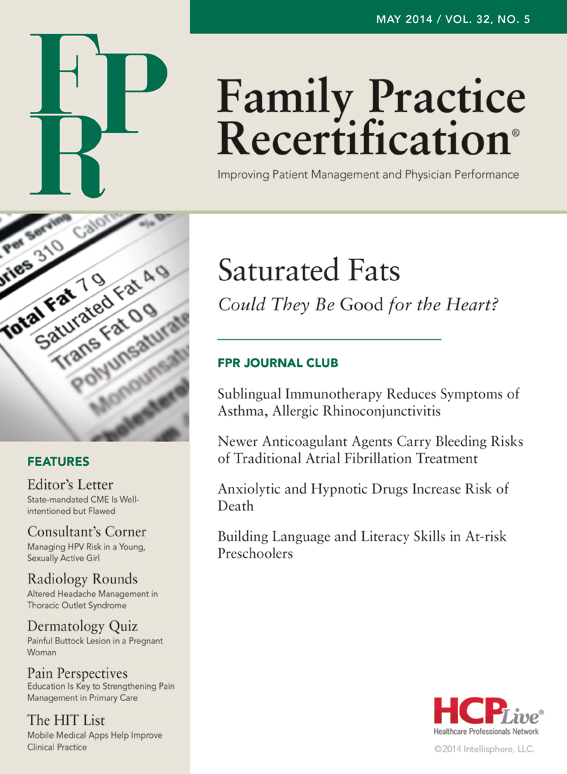Newer Anticoagulant Agents Carry Bleeding Risks of Traditional Atrial Fibrillation Treatment
As newer anticoagulants become accepted into clinical practice, it is important to consider their unique properties, potential benefits, and how they act in the coagulation cascade.
Review
Bloom, BJ, Filion, KB, Atallah, R, Eisenberg, MJ. Meta-analysis of randomized controlled trials on the risk of bleeding with dabigatran. Am J Cardiol. 2014 Mar 15;113(6):1066-74. http://www.ncbi.nlm.nih.gov/pubmed/24440332.
Study Methods
This systemic review and meta-analysis of randomized controlled trials (RCTs) compared the direct thrombin inhibitor (DTI) dabigatran to vitamin K antagonists (VKAs) in patients with either non-valvular atrial fibrillation (AF) or venous thromboembolism (VTE). Included in the review were RCTs that compared twice-daily 150 mg dabigatran — the dosage approved by the US Food and Drug Administration (FDA) for AF or VTE — with a VKA or low-molecular-weight heparin (LMWH) in adults for at least a 90-day duration. All studies were double blinded except for RE-LY, which was an open-label study on warfarin.
Patient Demographics
A total of 12,334 patients treated for AF and 7,998 treated for VTE were included in the review. The majority of the patients were male and the median age ranged from 55-77 years old.
Intervention and Control
In each study, patients were randomized to either twice-daily 150 mg dabigatran or a VKA for a length of time that ranged from 84 - 1,125 days. In the VKA group, the percentage of time spent in the therapeutic period ranged from 57-65%.
Results and Outcomes
Reported outcomes included clinically relevant non-major bleeding, major bleeding, fatal bleeding, bleeding resulting in a fall in hemoglobin ≥2g/dl, intracranial bleeding, intraocular bleeding, retroperitoneal bleeding, intra-articular bleeding, gastrointestinal (GI) bleeding, and all-cause mortality.
All of the trials found patients randomized to dabigatran had a lower risk of any bleeding compared to those taking VKAs. The incidence of major bleeding was also lower in the dabigatran group, but the finding was not statistically significant.
Although patients taking dabigatran had a higher risk of GI bleeding, their risk of intracranial bleeding was lower. While there was a trend toward lower all-cause mortality in the dabigatran group — largely due to a decreased risk of stroke or thromboembolism, rather than an improved bleeding risk — no trial showed a statistically significant difference.
Conclusion
For patients with AF or VTE, there was insufficient evidence to conclude twice-daily 150 mg dabigatran is significantly different from warfarin and other VKAs on the risk of all bleeding. However, dabigatran was associated with a relatively higher risk of GI bleeding, while VKAs were associated with a relatively higher risk of intracranial bleeds.
The non-statistically significant trend towards lower all-cause mortality suggests that dabigatran has a favorable safety profile compared to VKAs.
Commentary
When a healthcare provider and patient decide on an anticoagulant medication, many factors must be taken into account. One of these factors is bleeding risk, though other elements like medication adherence, pharmaceutical interaction, lifestyle adjustment, and reversibility may be more important in some cases. VKAs have well-established limitations that include dietary restrictions, a wide array of medication interactions, and frequent blood draws to ensure proper dosing — a problem reflected in this review, as it found no study averaged more than 65% of time spent within the therapeutic range for patients using VKAs.
This review deemed one alternative at least as safe as the old standard of warfarin in treating VTE or non-valvular AF, since there was a decreased risk of any bleeding in patients taking dabigatran, as well as lower intracranial bleeding risk. There was also a trend towards decreased all-cause mortality, driven largely by the decrease in stroke and thromboembolism — a finding that may reflect dabigatran is much simpler to dose consistently in most patients.
Nevertheless, VKAs did offer some benefit over dabigatran, as they were shown to have a lower risk of GI bleeding. Furthermore, vitamin K, prothrombin complex concentrate, and fresh frozen plasma are well-studied antidotes to VKAs, while a reversal agent for dabigatran has not yet been established. VKAs also require no specific dosing adjustments in patients with renal or hepatic insufficiency, while real dosing is required for dabigatran. Lastly, dabigatran is a much more expensive medication than warfarin.
This study helps providers quantify both the hazards and benefits of anticoagulation in patients at risk for thromboembolic events. As newer anticoagulants become accepted into practice, it is important to consider their unique properties, potential benefits, and how they act in the coagulation cascade, as outlined in this graphic.
Direct factor Xa inhibitors form another new class of anticoagulants currently in development, though several oral agents like apixaban and rivaroxaban have already been approved for AF and VTE prophylaxis. The onset of anticoagulant activity is generally rapid in this class, with peak action achieved within 2-4 hours. Like DTIs, routine monitoring is not required with direct factor Xa inhibitors. Parenteral DTIs such as argatroban and bivalirudin are also available, although they have not yet been approved for AF or VTE treatment, and the ability to reverse these agents is currently lacking.
A number of new pharmaceutical options are available to prevent embolization and stroke in AF and VTE patients, and several appear to have similar risk profiles without the drawbacks associated with classic VKA therapy. However, for most patients, there is no definitive “best therapy,” so the patient and provider must weigh the risks and benefits of each anticoagulation regimen in an informed consent discussion.
About the Authors
Matthew Propert, MD, is a general resident physician at the University of Massachusetts Medical School in Worcester, MA.
He was assisted in writing this article by Frank J. Domino, MD, Professor and Pre-Doctoral Education Director for the Department of Family Medicine and Community Health at the University of Massachusetts Medical School and Editor-in-Chief of the 5-Minute Clinical Consult series (Lippincott Williams & Wilkins).
